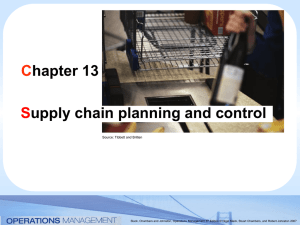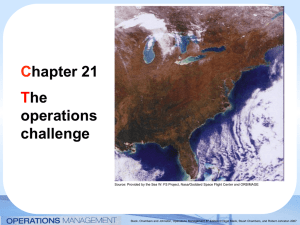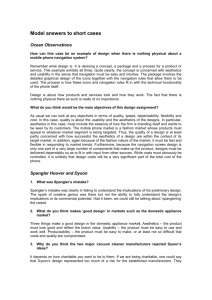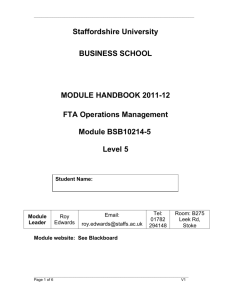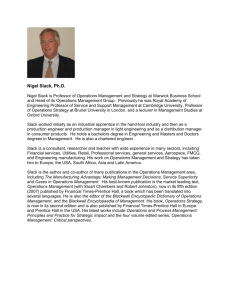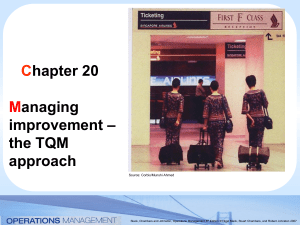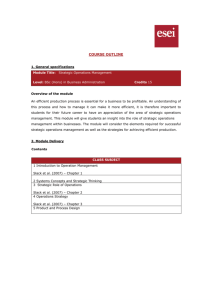Chapter 1 Powerpoint slides
advertisement
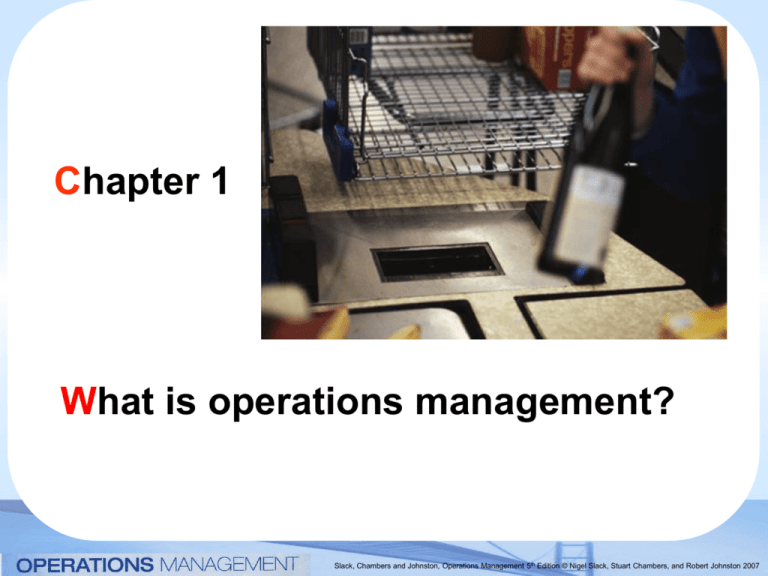
Chapter 1 What is operations management? Slack, Chambers and Johnston, Operations Management 5th Edition © Nigel Slack, Stuart Chambers, and Robert Johnston 2007 Operations management defined Operations management is the activity of managing the resources which are devoted to the production and delivery of products and services. Slack, Chambers and Johnston, Operations Management 5th Edition © Nigel Slack, Stuart Chambers, and Robert Johnston 2007 The consultancy services market – % of world revenues of 40 largest consultancy firms Financial 6 Organizational design 11 Marketing / sales 2 Operations and process management 31 Benefits / actuarial 16 IT strategy 17 Corporate strategy 17 The operations function is fashionable! Slack, Chambers and Johnston, Operations Management 5th Edition © Nigel Slack, Stuart Chambers, and Robert Johnston 2007 Back office operation in a bank Retail operation Kitchen unit manufacturing operation They are all operations Take-out / restaurant operation Slack, Chambers and Johnston, Operations Management 5th Edition © Nigel Slack, Stuart Chambers, and Robert Johnston 2007 Creating Customer Value Slack, Chambers and Johnston, Operations Management 5th Edition © Nigel Slack, Stuart Chambers, and Robert Johnston 2007 Operations management at IKEA Design elegant products which can be flat-packed efficiently Design a store layout which gives smooth and effective flow Site stores of an appropriate size in the most effective locations Maintain cleanliness and safety of storage area Ensure that the jobs of all staff encourage their contribution to business success Continually examine and improve operations practice Monitor and enhance quality of service to customers Arrange for fast replenishment of products Slack, Chambers and Johnston, Operations Management 5th Edition © Nigel Slack, Stuart Chambers, and Robert Johnston 2007 All operations are transformation processes … Inputs Transformation process Outputs that transform inputs … into outputs Slack, Chambers and Johnston, Operations Management 5th Edition © Nigel Slack, Stuart Chambers, and Robert Johnston 2007 Some inputs are transformed resources Some inputs are transforming resources Transformed resources … Input resources Transformation process Output products and services Customers Transforming resources … Outputs are products and services that add value for customers Slack, Chambers and Johnston, Operations Management 5th Edition © Nigel Slack, Stuart Chambers, and Robert Johnston 2007 At Prêt a Manger Transformed resources … ? Input resources Served and satisfied customers Transforming resources … ? Slack, Chambers and Johnston, Operations Management 5th Edition © Nigel Slack, Stuart Chambers, and Robert Johnston 2007 The output from most operations is a mixture of products and services Crude oil production Acme Whistles Pure products – Outputs that are exclusively tangible Aluminium smelting Specialist machine tool production Prêt a Manger Restaurant Information systems provider IKEA Mixture of products and services – Outputs that are a mixture of the tangible and the intangible Management consultancy Mwagusi Safari Lodge Psychotherapy clinic Pure services – Outputs that are exclusively intangible Slack, Chambers and Johnston, Operations Management 5th Edition © Nigel Slack, Stuart Chambers, and Robert Johnston 2007 Characteristics of Goods v Services Contrast the characteristic differences between Manufacturing and Services over the following factors:- Manufacturing <> Product Inventory Customer Contact Response times Markets Facilities Capital Labour Quality Service Slack, Chambers and Johnston, Operations Management 5th Edition © Nigel Slack, Stuart Chambers, and Robert Johnston 2007 Differences within sectors are often greater than the differences between sectors Financial services An account management centre at a large retail bank Financial analyst advising a client at an investment bank Furniture manufacturing Mass production of kitchen units Craft production of reproduction ‘antique’ furniture Hotels Value-for-money hotel Lobby of an international luxury hotel Slack, Chambers and Johnston, Operations Management 5th Edition © Nigel Slack, Stuart Chambers, and Robert Johnston 2007 A Typology of Operations Low Volume High High High Variety Low High Variation in demand Low High Visibility Low Slack, Chambers and Johnston, Operations Management 5th Edition © Nigel Slack, Stuart Chambers, and Robert Johnston 2007 Implications Low repetition Each staff member performs more of job Less systemization High unit costs Flexible Complex Match customer needs High unit costs Changing capacity Anticipation Flexibility In touch with demand High unit costs Short waiting tolerance Satisfaction governed by customer perception Customer contact skills needed Received variety is high High unit costs A Typology of Operations Low High High High Volume Variety Variation in demand Visibility Implications High High High repeatability Specialization Capital intensive Low unit costs Low Well defined Routine Standardized Regular Low unit costs Low Stable Routine Predictable High utilization Low unit costs Low Time lag between production and consumption Standardization Low contact skills High staff utilization Centralization Low unit costs Slack, Chambers and Johnston, Operations Management 5th Edition © Nigel Slack, Stuart Chambers, and Robert Johnston 2007 4 V’s profile of two operations Low Volume High High Variety Low High Variation Low High Visibility Low Mwagusi Safari Lodge Formule 1 Hotel Important to understand how different operations are positioned on the 4 V’s. Is their position where they want to be? Do they understand the strategic implications? Slack, Chambers and Johnston, Operations Management 5th Edition © Nigel Slack, Stuart Chambers, and Robert Johnston 2007 Decisions in Operations Five major decision areas: Process Quality Work force Inventory Capacity Schroeder Section 1.6 - page 16 Operations Management Slack, Chambers and Johnston, Operations Management 5th th Edition © Nigel Slack, Stuart Chambers, and Robert Johnston 2007 R G Schroeder, Operations Management, 4 edition,1993, McGraw Hill Some interfunctional relationships between the operations function and other core and support functions Engineering/ technical function Accounting and finance function Product/service development function Operations function Marketing function Human resources function Information technology (IT) function Micro Environment Slack, Chambers and Johnston, Operations Management 5th Edition © Nigel Slack, Stuart Chambers, and Robert Johnston 2007 Case : Too Short The Day Analysis What is Giles trying to do ? What is Giles actually doing ? What are the problems within the organisation ? Recommendations What should Giles do ? What changes if any should the organisation make ? Identify the functions of a manager Identify the levels of management Slack, Chambers and Johnston, Operations Management 5th Edition © Nigel Slack, Stuart Chambers, and Robert Johnston 2007 Case : The Glastonbury Festival 1 What is the role of an operations manager such as Michael Eavis in this situation? How does this change at different stages of the festival organisation? 2 List the different types of transformation processes involved in the festival activities within the classifications: Materials/Information/Customer 3 Relate the 5 decision areas as outlined in R G Schroeder’s Operations Management, to the Glastonbury case. Slack, Chambers and Johnston, Operations Management 5th Edition © Nigel Slack, Stuart Chambers, and Robert Johnston 2007
